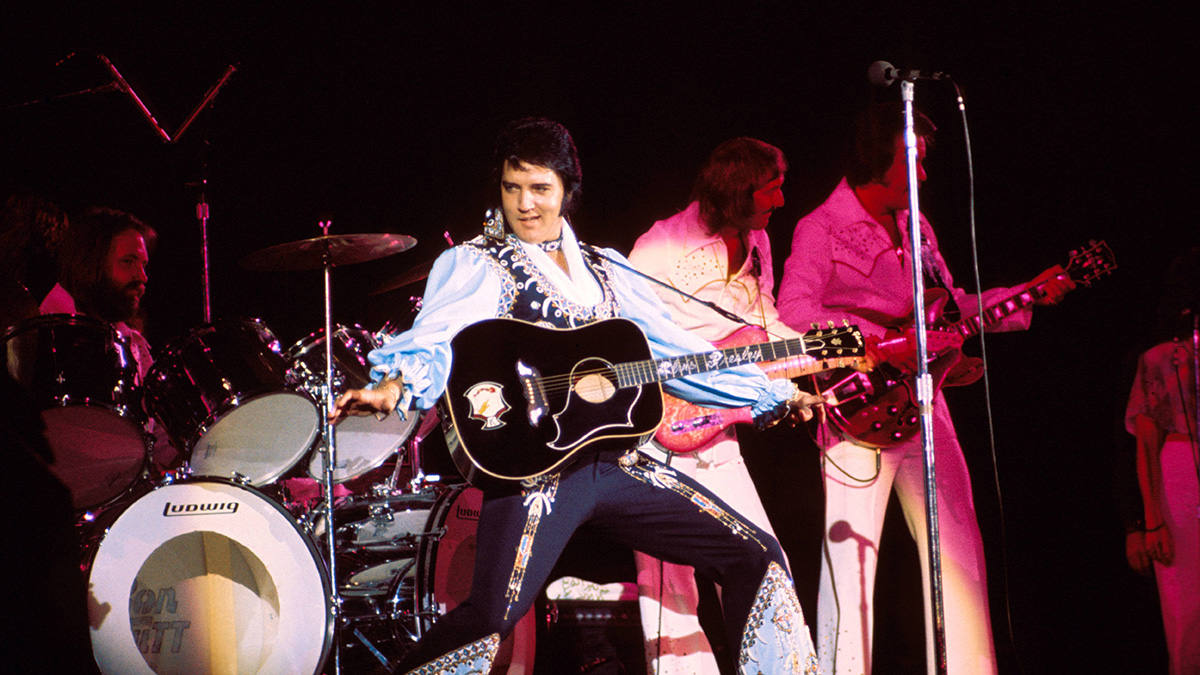10 essential Elvis Presley guitar tracks
Plus! Learn how to play three classic Elvis riffs with video lessons on Jailhouse Rock, Mystery Train and Suspicious Minds

With the Baz Luhrmann Elvis biopic rocking the multiplex over the summer, it is perhaps understandable that the world has gone crazy once more for the King, and a new generation of guitarists have been introduced to his guitar legacy.
Here, we look at 10 tracks that make for the perfect introduction to the Elvis Presley rock 'n' roll phenomenon, and a cultural footprint that has made its presence felt on acoustic and electric guitar styles over the years – a young modern beat combo from Liverpool, England were but four musicians to have paid particular attention to his work.
And, to finish off, we'll walk you through three Elvis classics, which could be branded as a foundational lesson in rock 'n' roll guitar, as the riffs to these are woven into the very fabric of the art form.
1. Hound Dog (1956)
Elvis’s treatment of Hound Dog is very unlike the 1952 original by Big Mama Thornton, written for her by Jerry Lieber and Mike Stoller. The lyrics were altered to reflect Elvis’s gender and to clean up the original’s sexual innuendo.
Elvis chose ‘take 28’ of the 31 attempts, but by this time his trusted guitarist Scotty Moore was getting frustrated, so on his second solo – the first is a brilliant spontaneous outing – made a few weird percussive noises and knocked out a couple of random licks.
Keith Richards said it sounded like Scotty had thrown the guitar on the floor, picked it up and got the perfect sound.
2. Too Much (1956)
This track contains one of Scotty Moore’s most outlandish solos. We’ll let Scotty explain, as he did to Guitarist magazine in 1992.
Get The Pick Newsletter
All the latest guitar news, interviews, lessons, reviews, deals and more, direct to your inbox!
“There’s a boy on this tour we just finished, plays every note I ever played – even the bad ones,” he jokes.
“Too Much was in an unusual key for us at the time. It was in Ab, and we’d done two or three takes, but on this particular cut I just got absolutely bonkers, just got lost, but somehow I came out of it and that’s the one Elvis picked. But anyway, this young guitarist would play that sucker note for note!”
3. Love Me Tender (1956)
The song was written by Ken Darby and George Poulton for the movie of the same name, but producer David Weisbart did not want Presley’s usual band on the recording and insisted that Ken Darby’s trio, with Vito Mumolo on guitar, did it.
A simple nylon-string guitar part using spread chords interspersed with bass notes, Love Me Tender is in D, but for the bridge chords of D, F#m, Bm, D7, G, Gm, D, Mumolo plays D, F#7/C#, Bm, D/A, G, Gm, D, providing a partial chromatic rundown in the bass. It’s a simple but effective arrangement trick.
4. King Creole (1958)
This was the title track to Presley’s fourth film, for which he garnered critical praise for his performance of cajun guitarist Danny Fisher. The song itself is a hot-tempo 12-bar blues in B, with Elvis and his band augmented by harmony vocals from the Jordanaires. Scotty Moore powers the track from top to tail, with a driving riff played on his Gibson Super 400.
The inevitable guitar solo is an explosion of tremolo-picked B notes high on the top string, cascading into tasty blues scale licks, string bends and doublestops. It’s one of Scotty’s most exciting lead breaks ever.
5. Guitar Man (1967)
This superb song was written and originally recorded by country guitar phenomenon Jerry Reed. Reed used the classic pick and fingers technique pioneered by Merle Travis and dubbed ‘Travis picking’, and even though Reed used nylon-string on both his and Presley’s first recording of Guitar Man, it gives the track both movement and excitement.
Presley had tried to record the song before, but was unhappy with the feel so demanded that they get “that red-neck picker who played on the original tune.” Jerry obliged, nailing it in just a few takes.
6. Always On My Mind (1972)
There are great versions of this song by ‘Little Miss Dynamite’ Brenda Lee, country megastar Willie Nelson, and British synth-pop duo Pet Shop Boys. Yet somehow Elvis made it his own.
By this time he was using his Las Vegas live band for studio sessions, including guitarist James Burton. Burton had made his name with Ricky Nelson, and his solos on tracks such as Hello Mary Lou are legendary.
There’s not much lead work here, but what there is perfect – just plaintive string bends and a perfect solo that apes the song’s melody. Could it have inspired Clapton’s playing on Wonderful Tonight?
7. Burning Love (1972)
Still depressed after his failed marriage to Priscilla, Elvis only seemed interested in singing ballads, but Burning Love seemed an obvious hit to all around him, and Presley finally caved in. Six takes and it was done!
The electric guitar is attributed to James Burton, but the heavily effected solo and fills are not typical JB (there’s whammy bar here and James played a Tele).
But it’s a great example of rhythm guitar used as lead instrument so was it in fact Elvis’s rhythm guitarist, John Wilkinson, with James playing the verses’ chord stabs? It remains a mystery. But this was Elvis’s final hit before his death in 1977.
8. Mystery Train (1955)
Often cited as the first real rhythm and blues song to be recorded by a white artist, Mystery Train was written by bluesman Junior Parker, but the Presley version is almost twice as fast as Parker’s original.
Propelled by just Elvis on vocals and his ‘Sun Sessions’ Martin D-18, with Bill Black on bass and Scotty Moore on electric rhythm and lead, it was a straight live take. Piling on slapback echo, Scotty played the riff – E and A/E, with alternate E octave notes using pick and fingers; cracked out a solo featuring string bends, chord tones and fragments, and more or less invented rockabilly right there.
Our video lesson takes you through Moore’s intro and verse lines, which, although comprising a lengthy section of the song, boils down to just four chords (E, A/E, A7 and B7) and some repeating picking patterns. Learn the chord shapes first, then slowly experiment with picking out the notes.
For a smooth change when changing from the E chord to the A/E, use your third finger to barre across the 2nd fret and hold all three notes of the open A major.
9. Jailhouse Rock (1956)
This song is ultra-cool for several reasons. First is Elvis Presley’s stunning dance routine in the film, wearing a jailbird’s striped T-shirt. Second is the ‘stops’ and anticipatory drums between Elvis’s spat-out verses. Then there was the key.
The song is in Eb and Scotty Moore plays the typical ‘walking arpeggio’ riffs, but when it comes to the low Eb note (an E in standard tuning), he plays the open sixth string. Scotty did sometimes tune down (as he did on Don’t Be Cruel), so who knows? Anyway, our video lesson is in E, to save you the hassle of tuning down!
We’ll cover the D# to E major intro chords and the walking bassline from the chorus. It’s a simple one-bar lick – you just have to transpose it note for note through the A, E, B, A, E progression. Navigate the tricky move to the implied B chord in the chorus by sliding up to the 6th fret with your third finger.
10. Suspicious Minds (1969)
With Elvis delivering an impassioned vocal fuelled by his recent split from wife Priscilla, Suspicious Minds was recorded during the same Memphis sessions that yielded another classic, In The Ghetto – and both tracks featured Reggie Young on guitar. The whole of Suspicious Minds hangs on Reggie’s super tight fingerstyle playing (on a Gibson Super 400, we think), performed with impeccable timing and squeaky clean tone.
Though the phrasing is similar to In The Ghetto (which uses an open A shape), here you’ll be following a 3rd-fret G barre chord and a C/E on the adjacent strings, before moving the riff up the fretboard to the 8th and 10th frets.
We’ll give you the finer details in the video lesson. Suffice to say, if you can manage the opening bar of music the rest should feel familiar and, dare we say, fairly easy!
Avoid finger fatigue and try not to play a full barre on the opening G chord – you only need to pick the four bass strings here.
In the late '70s and early '80s Neville worked for Selmer/Norlin as one of Gibson's UK guitar repairers, before joining CBS/Fender in the same role. He then moved to the fledgling Guitarist magazine as staff writer, rising to editor in 1986. He remained editor for 14 years before launching and editing Guitar Techniques magazine. Although now semi-retired he still works for both magazines. Neville has been a member of Marty Wilde's 'Wildcats' since 1983, and recorded his own album, The Blues Headlines, in 2019.










